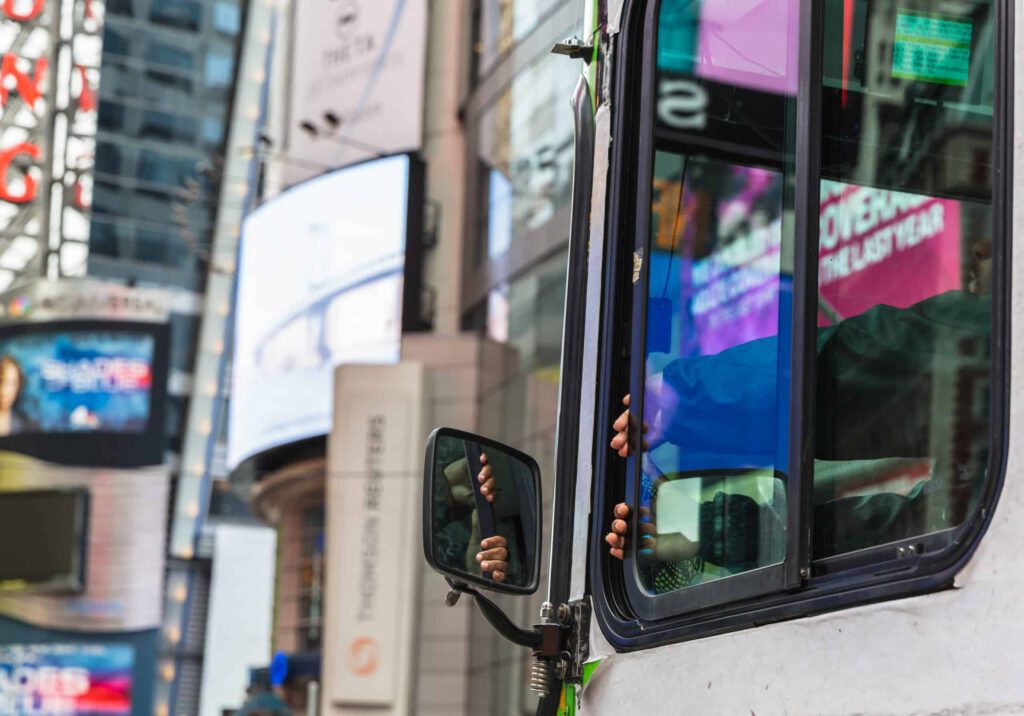The Baiting Hollow Scout Camp bus driver, whose BAC level was roughly six times the legal limit, now faces multiple criminal charges.
The 61-year-old bus driver was transporting campers and staffers when she hit a large concrete pillar, ran a stop sign, and sideswiped a car near the intersection of Oak Hills and Sound Avenue.
According to the Riverhead Police Department, she left the scene of both collisions. Authorities eventually tracked her down and charged her with multiple criminal counts, including DUI and child endangerment.
At a brief hearing, her lawyer noted that this arrest was her first one and that her husband recently died.
Judge Sean Walter was unimpressed. “While I find this is not a bail eligible offense, I am going to put her in pretrial supervised release…given the nature of the circumstances,” he ruled.
“The endangerment of the children, the high blood alcohol content, it would appear to the court there may be a substance abuse problem here.”
In a statement, the Suffolk County Council of the Boy Scouts of America claimed there were no injuries and that it would not comment further about this “ongoing investigation.”
First Party Liability in Alcohol-Related Wrecks
More than likely, there were injured victims, but they do not know they were hurt.
Head injuries, which are one of the most common car wreck injuries, are a good example.
The violent motion in a collision, such as a vehicle being sideswiped, caused the brain to slam against the inside of the skull. Since these victims show no visible symptoms, and since the brain conceals its own injuries, they may not promptly receive the treatment they need.
So, even if you “feel fine” after a wreck, always have an attorney evaluate your claim and connect you with an experienced car crash physician.
When the tortfeasor’s (negligent driver’s) BAC level is so high, first party liability is relatively easy to establish. According to the negligence per se doctrine, tortfeasors could be liable for damages as a matter of law if:
- They violate the DUI law or another safety law, and
- That violation substantially causes injury.
Although no additional evidence might be needed, evidence could be admissible in terms of damages.
The above case is a good example. Once jurors hear that the driver caused a pair of hit-and-run wrecks, they are more likely to award maximum compensation.
This compensation usually includes money for economic losses, such as medical bills, and noneconomic losses, such as pain and suffering.
Many drivers are dangerously impaired, yet not legally intoxicated. Alcohol impairment begins with the first drink. In contrast, most people are intoxicated after three or four drinks.
Compensation is still available in these situations. A New York personal injury attorney must use circumstantial evidence to establish impairment by a preponderance of the evidence, or more likely than not.
Such evidence includes:
- Erratic driving prior to the crash,
- Slurred speech,
- Bloodshot eyes,
- Unsteady balance, and
- Odor of alcohol.
This evidence could also prove that the bar, restaurant, or other commercial establishment which furnished alcohol is financially responsible for damages.
A preponderance of the proof is one of the lowest standards of evidence in New York law. So, a little evidence goes a long way.
Third Party Liability
When a commercial driver, like a bus driver, Uber driver, or truck driver, causes a wreck, the respondeat superior doctrine usually applies. Employers, such as summer camps, are vicariously liable for vehicle collision damages if:
- Employee: For negligence purposes, anyone the employer controls is usually an employee. That includes people like unpaid volunteers. Employer control in this area includes things like route driven and stops made.
- Scope of Employment: On a similar note, any act which benefits the employer in any way is usually within the scope of employment. That includes acts like driving an empty bus back to a garage.
Other employer liability theories, which frequently apply in nursing home abuse and other intentional tort claims, include negligent hiring and negligent supervision.
Regardless of the tortfeasor’s status, New York’s dram shop law often applies in alcohol-related wrecks.
As mentioned, this law holds commercial providers responsible for damages if they illegally sell alcohol, and that patron causes a car crash. It’s illegal to sell alcohol to underage people. It’s also illegal to sell alcohol to anyone who is “visibly intoxicated.”
The aforementioned physical symptoms could establish intoxication at the point of sale. The same burden of proof, a preponderance of the evidence, applies.
Noncommercial providers, such as social hosts, could also be vicariously liable in some situations, under a theory like negligent undertaking.
Third party liability is especially important in catastrophic injury claims, like wrongful death claims. New York has one of the lowest auto insurance minimum requirements in the country.
Therefore, many tortfeasors don’t have enough insurance coverage to provide fair compensation in these matters. Vicarious liability gives these victims an additional source of recovery.
Impaired drivers often cause serious injuries. For a free consultation with an experienced New York personal injury attorney, contact Napoli Shkolnik PLLC. We do not charge upfront legal fees in these matters and only recover a fee if we win the case.
